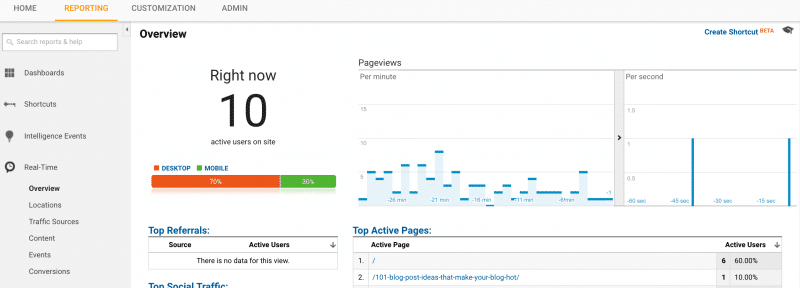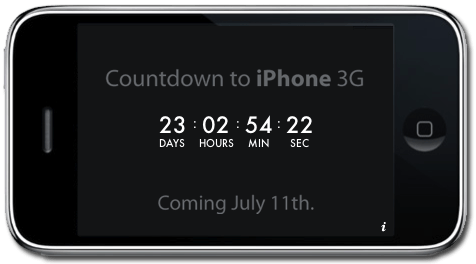
We all want as many people to read our posts as possible – to see huge amounts of traffic flooding in and page after page of real, live comments from adoring fans and engaged audience members.
Ahhh… the dream!
So we spend time thinking about SEO and planning out content we think people will care about. But what if I told you that great content and solid optimization aren’t enough?
Table of Contents
What is the best time to post a blog?
There is no universal best time to post a blog. To find out the best time for your blog, sign into Google Analytics and navigate to Realtime -> Overview. Check this throughout the day to find out when your users are online the most.

If you want to go a step further, click on the Audience option right below “Overview”. Then, click on Geo -> Location and you can see which countries and even states are actually visiting your site. If your audience is primarily business people in the U.S. on the East Coast and you are posting in the afternoon, few of your readers will actually see it since they are 3 hours ahead and commuting back from work during this time!
What if I told you there is a wrong time to blog?
I’m not talking about writing posts – but when you actually publish them.
What most bloggers don’t realize is that there are times of the week and hours of the day it’s better to set your post live.
Let’s state what should be obvious: If you’re writing about breaking news or trending topics, timing is absolutely everything, and sooner is better than later 100% of the time. Day, night – it doesn’t matter, you’ve got to move as quickly as possible to be one of the first to break the news.
I learned this lesson firsthand when I began blogging about smartphones and smartphone tutorials
I understood that I had to crank out “hot topics“ like new phone releases and specs as soon humanly possible. So, when the iPhone 2 launched (which seems like forever ago, doesn’t it?), I was on the ball!

When the next iPhone was unveiled, I gambled on a different approach. This time, I took a lot of time refining the post, editing it and trying to make it *perfect* and trying to be the most complete post with the most information of anyone out there.
I wondered if I spent more time tweaking the writing, responses would be stronger. Sadly, this experiment belly-flopped. Big time! Every blogger had beat me to the punch, so my post went unnoticed.
Worse still, the few people that did stumble upon my post left uninformed, because I was repeating information they already KNEW.
The most important lesson I learned was to respond as quickly as possible to emerging events and updates.
Not hip to what’s happening in your niche? Try browsing the front page of reddit or checking out hashtags on Twitter.
What about posts that aren’t about breaking news or time-sensitive topics?
You’re probably well aware that these posts need to prioritize quality over speed. What you may not know is that there are actually better times to publish these posts too – but the answer might not be what you expected.
See, depending on who you ask, the “best time” seems to change from person to person, company to company.
For example…
- Matt McGee published an article definitively naming 2:37 PM PST on Sundays as the best time to publish blog posts. That seems oddly specific, right? And all he based it on was one of his own most successful posts, so it seems unreliable. But…
- Dan Zarella from Hubspot did a study, summarized by KISSMetrics, that suggests that posts get the most traction on Mondays at 11am EST… except, he found that posts got the most comments on Saturdays at 9am. That seems weird, right? Except…
- Noah Kagan did a huge study of 100 million pieces of content and found that blog posts published on TUESDAY gained the largest total shares and were the most likely to go viral. And yet…
- In my own study, I found that the best times to post on my blog were in the evenings, especially on Fridays and Saturdays. For some reason, my traffic seemed to flag during the workweek, only to gain steam during the weekend. This meant that content posted on Friday or Saturday evening saw a lot more exposure and stirred up way more interest than most content I wrote during the week.
Is your head spinning yet?
Who do you trust?
Which data is accurate?
The surprising truth is, there IS NO universal best time to publish
What works for one blog might not work for yours – and even if we see averages from hundreds of millions of posts, there’s always a chance that your audience will have different consumption habits, or that you will find your own blog to have a different publishing time that works best.
That’s right – your peak time is something completely different.
So while you might use Noah Kagan’s study or Dan Zarella’s as a starting point, it’s up to YOU to test and discover the best time for your blog.
Here's how
If you’re not already using Google Analytics to track your traffic, there’s no time like the present to start.
It’s just one of the many tools available to bloggers that can help you turn a humdrum piece of content into flypaper, which sucks new readers in.
Within Google Analytics, you’re going to want to do a few things:
- Use annotations to mark down the publish time of every single blog post you publish. It only takes a few seconds, and will give you some data points to compare against.
- Then, view your data over time by sorting your overall visitors by the hour to see which days and hours have the most common peaks. (You can also create custom reports for this)
- Want even more info? This post from Coschedule has two awesome custom reports you can set up to get an even better look at your blog’s own best publishing time (see #5 and #6!)
Make sure that you’re looking at the data over a long enough time period – just one week isn’t likely to be statistically significant.
But the other surprising truth…
The best publishing time might not even matter!
See, there are three other things that are more important…
- The quality of your content: An incredible piece has a better chance at getting shared at ANY time than a mediocre one, so if nobody is sharing your content, EVER, this is where to start.
- The time you SHARE the content: Who cares what time you publish the post if you can share it at ANY time? You’re going to want to pay attention to when your piece gets the most traction after you share it on different social media channels. Sure, publish that post at 8:00am – then share it three hours later if that makes more sense! Sharing patterns can differ from direct consumption patterns, so test them separately and try sharing/publishing at different times, too.
- How frequently/consistently you publish content: If your audience gets into a rhythm and knows your content is coming at a certain time or on a certain day, you can be a part of shaping their consumption habits!
There’s no hard rule here—some professional bloggers even churn out new content every 24 hours.
While that schedule may be too demanding for you, you should consider posting often and at regular intervals. I’ve found that 2 or 3 times a week is a sweet spot—any more than this, and customers can feel overwhelmed, any less and I risk fading from memory.
But, test for yourself – and set a schedule you can reasonably manage.
(Pssst… Worried you can’t find enough content to occupy those words? I have 101 ideas for blog posts to keep that idea mill churning. Or you might try a strategy that I see a lot of bloggers using: dedicate certain days of the week to specific kinds of posts—maybe every Friday is a “weekly roundup,” for example.)
- How frequently you share the content: Too many bloggers abandon their old posts to focus on new ones, sharing it once or twice and never sharing again. Unless your content deals with a time-sensitive issue, there’s absolutely no reason you can’t share old but relevant content over and over and over again at different times, testing to see when it gets the most traction.
Don’t forget, there’s a lot of reasons you should start your own blog, and keeping your site current and trending is just one of them!
Did I overlook a posting schedule or strategy that took your blog by storm? Drop me a comment and tell me about it!

Our #1 Choice For Hosting Blogs
62% Off Exclusive Offer Applied at Checkout
Regularly
$6.95/mo
Starting From
$2.64/mo*
- Free 1 Year Domain Registration on Select Plans
- FREE SSL Certificate
- Drag-and-drop Website Builder
- E-commerce Ready
- 1-Click WordPress Installation



